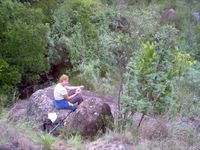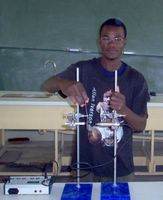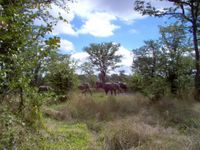We're now in Livingstone, our second visit here but the Falls on the Zambian side are a trickle compared with the rainy season. We have travelled across Tanzania into Malawi and then west into Zambia. In Tanzania before the border we passed through Baobab valley along the Great Ruaha river with lots of the so called "Upside Down Trees" or Baobab trees; so many along the river valley and slopes. We also visited Isimila Stone Age Site because we had a days wait whilst a new trip member caught up with us. We reached the Malawi border on 6 October and then travelled south to Lake Malawi at Chilumba. The next day was onwards south up a steep valley side and then down to "Kandy Beach" on the shores of the lake. This was our home for a couple of days. The top of the escarpment was about 890 m with the lake shore at about 370 m so still above sea level. We commissioned some "T" shirts with a map of Africa on the back with the countries we've visited on including Angola (keep this to yourself) and Rwanda but they missed off Uganda and also used second hand shirts, so I guess we should know better!!
By Monday we were on the road again out of Malawi into Zambia. It was beginning to feel like we knew the area more as we approached Namibia! It was a long-long day as we had to catch up on a missed day, but worth the very rough drive to the Laungwa park. This was a great experience as we were able to walk with a guide in the reserve and see the animals at first hand. There are lions and leopards but we didn't see them whilst walking but did see hippos, buffalo and elephants at close quarters. We slept on a tree platform and saw elephants going through the camp. The highlight of the trip was a night drive when we saw a leopard kill an Impala at close quarters, within 3 metres. There was torrential rain during the drive, their first rain in October for 5 years !!, but it let-up a little for us to see the leapard and also many hippos going for an evening stroll. We also saw a pride of lions crossing the river and dodging the crocodiles (we could see the light reflected in their eyes). Luckily the rain was localised and when we got back to the camp everything was dry (we'd left the flysheet off the tent so it could have been a different story).
From there we drove south to Lake Kariba and 3 nights on a house boat. Didn't see much of the lake but it was luxury to have a proper bed and a boat not a truck to live in.
The campsite here in Livingstone is not as nice as "Fawlty Towers" where we stayed before with Alison and Margaret, but with a name like "Grubby's Grotto", what can you expect. The money is called Kwatcha and is difficult to get use to with 7000 to a pound so I'm almost a millionaire here. We did an activity yesterday, a jet boat trip up and down rapids, the closest we'll get to white-water rafting. We drove downstream of the falls and got a wire lift down to the river. As it is dry season (no real rain here yet) the river was low. Some of our group were doing rafting and we met them on the way down. Of course we all got very wet as the waves on the rapids came over and he kept doing these rapid turns with the aim of wetting everthing. Helen was stood on a sand bank next to the river and literally got swept off her feet as a wave from the boat came ashore and she ended flat on her back covered with water. Anyway, it was hot and we all dried off quickly during the journey back to the campsite.
Now looking forward to independent travel as we are both feeling the effects of the truck and group travel. It will be nice to decide where we want to stop and for how long. In retrospect, it would have been easy to do the trip with the Pajero, it would have taken twice as long because we'd have stopped longer in places but there are no problems finding accomodation or the state of the roads is nothing worse than we met in Nambia. However, the down side is still the cost and also selling the car at the end.
Next is Durban where we plan to hire a car and travel up the coast to St Lucia wetlands. Not sure after that....keep in touch.
 Weavers at their nest at Leopard Rock.
Weavers at their nest at Leopard Rock. After Coffee Bay we reached East London in the rain and decided to stay dry in a BP in the town. Very quiet and a little dismal with unfriendly staff giving us the impression the place had seen better days. So with the tent dried in our room, we moved off to Jeffrey's Bay, or J-Bay as it is known. We originally sought camping as the weather had improved but got offered a BP "Misty Cove" (13 th November) and double room with en-suite for the same price (40R ppn) so stayed for a couple of days. This is South Africa's big surf beach and although it was the quiet season, the place was full of surf shops etc. The beach was long and windy, but only a few surfers around. We did catchup on the cinema with a personal showing of "My ex-girlfriend" and shopping put into their fridge!! We found a great restaurent "The Wallklipper" further south along the beach from J-Bay, lots of seafood options so Helen was in her element of course.
After Coffee Bay we reached East London in the rain and decided to stay dry in a BP in the town. Very quiet and a little dismal with unfriendly staff giving us the impression the place had seen better days. So with the tent dried in our room, we moved off to Jeffrey's Bay, or J-Bay as it is known. We originally sought camping as the weather had improved but got offered a BP "Misty Cove" (13 th November) and double room with en-suite for the same price (40R ppn) so stayed for a couple of days. This is South Africa's big surf beach and although it was the quiet season, the place was full of surf shops etc. The beach was long and windy, but only a few surfers around. We did catchup on the cinema with a personal showing of "My ex-girlfriend" and shopping put into their fridge!! We found a great restaurent "The Wallklipper" further south along the beach from J-Bay, lots of seafood options so Helen was in her element of course.























